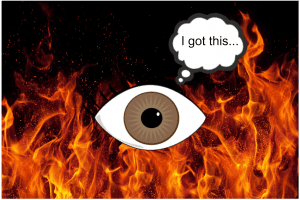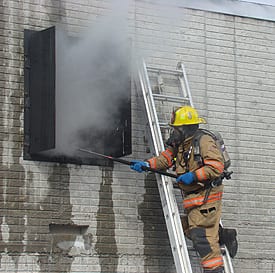 The tones drop for an apartment building fire. On the way, dispatch is advising multiple calls, confirming a working fire and the possibility of people trapped. The mind of the officer on the aerial platform is busy processing – thinking – anticipating – what will need to be done upon arrival? Of course, truck work is on the officer’s mind: Forcible entry; search and rescue; ventilation. The officer takes a deep breath and smiles. It’s going to be a good day.
The tones drop for an apartment building fire. On the way, dispatch is advising multiple calls, confirming a working fire and the possibility of people trapped. The mind of the officer on the aerial platform is busy processing – thinking – anticipating – what will need to be done upon arrival? Of course, truck work is on the officer’s mind: Forcible entry; search and rescue; ventilation. The officer takes a deep breath and smiles. It’s going to be a good day.
The Pre-arrival Lens
The pre-arrival lens is the visual image formed in the officer’s mind about what is going to be seen on arrival. The lens helps the officer anticipate and plan. The lens can also help the officer mentally prepare for the worst-case scenario.
SIDE NOTE: When I was a young firefighter, a seasoned officer told me that I should envision the worst-case scenario and hope for the best-case scenario. What I envisioned was my pre-arrival lens – my understanding of what I could expect to see when I got there.
Goal Setting

The pre-arrival lens can help a responding officer do some goal setting before arriving on the scene. This can be both an advantage and a disadvantage. The advantage is that the goal can be set and the plan can be communicated to the crew so everyone can mentally prepare for the task. The disadvantage is that the plan may not fit the conditions once the crew arrives.
Set in Stone
Plans can be easy to make and hard to change. Once set into motion, either mentally or physically, it can be difficult to change a course of action or stop a plan. It is much easier to implement the plan without conducting an assessment to determine if the conditions actually justify (and support) the plan.
Blinded
Here are some questions I posed recently during a program in which we were discussing flawed situational awareness:
1. Is it possible that an officer could be so focused on the mission that dangerous conditions would go unnoticed?
2. Is it possible that an officer could be so focused on the mission that dangerous conditions would get noticed… but the officer would not understand (comprehend) how bad the conditions actually are?
3. Is it possible that an officer could be so committed to the mission that dangerous conditions get noticed AND the dangers are understood… yet the officer chooses to completely ignore the conditions because of his or her commitment to the mission?

Following a discussion of all the ways mission myopia can flaw situational awareness, I showed the students a video clip. In the clip, a crew of firefighters was performing a highly risky vertical ventilation operation while, adjacent to where they were working the fire had, most evidently, burned through the roof and massive amounts of fire and smoke were billowing out the hole.
And the exclamation point was put on the lesson. What were these firefighters doing in the roof? What was their mission? Were they assuming risk or creating risk by being there? Were they doing anything that would make the situation better?
Dr. Gasaway’s Advice
Begin with the end in mind. When setting a goal to accomplish at an incident scene, ask yourself:
 1. If we are able to successfully complete this goal, how will the outcome of the incident be improved?
1. If we are able to successfully complete this goal, how will the outcome of the incident be improved?
2. Do we have the right resources (here, now) to successfully accomplish the goal?
3. How much time do we have to accomplish the goal before the fire overruns us, or structural integrity becomes compromised?
4. What will be the clues and cues that would serve as the indicators that it is time for us to abandon the goal?
5. Do we have a viable plan for extricating ourselves from the situation if conditions take a turn for the worse?
Asking these tough questions, in advance of engaging, can help you make a realistic assessment of the risks you are taking and help you anticipate potential bad outcomes before they happen.
Action items
 1. Discuss a time when you observed mission myopia and the risks that resulted when it happened.
1. Discuss a time when you observed mission myopia and the risks that resulted when it happened.
2. Discuss actions you can take to avoid mission myopia.
3. Discuss strategies for what you could/should do if you observe someone else displaying mission myopia at an incident scene.
_____________________________________________________

If you are interested in taking your understanding of situational awareness and high-risk decision making to a higher level, check out the Situational Awareness Matters Online Academy.
CLICK HERE for details, enrollment options and pricing.
__________________________________
Share your comments on this article in the “Leave a Reply” box below. If you want to send me incident pictures, videos or have an idea you’d like me to research and write about, contact me. I really enjoy getting feedback and supportive messages from fellow first responders. It gives me the energy to work harder for you.
Thanks,

Email: Support@RichGasaway.com
Phone: 612-548-4424
SAMatters Online Academy
Facebook Fan Page: www.facebook.com/SAMatters
Twitter: @SAMatters
LinkedIn: Rich Gasaway
Instagram: sa_matters
YouTube: SAMattersTV
iTunes: SAMatters Radio
iHeart Radio: SAMatters Radio
